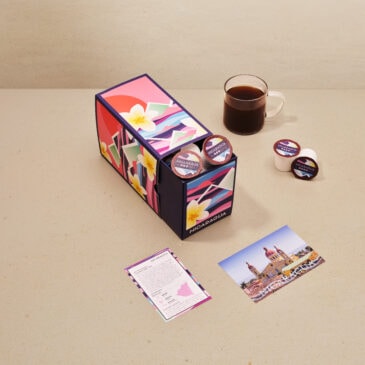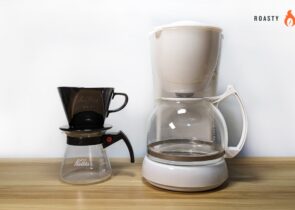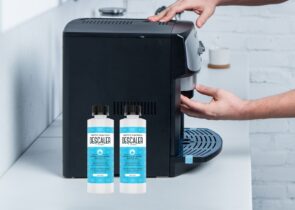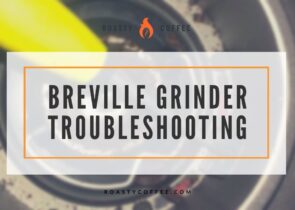If you read articles on here often, you are probably wondering why we are even writing about Keurig coffee makers. As coffee geeks, we want the best taste possible, which usually means a manual brewing method like the Aeropress or a French Press.
But let’s be realistic. A lot of people don’t have time for all of that, and they just want a fast, single-serve coffee machine that brews a solid cup. So considering that, let’s compare two Keurig models, the K45 and the K40.

"The best coffee pod I've ever tasted"
Yes, we mean that. Finally, specialty coffee for your KCup machine, roasted fresh to your order by our friends at Atlas Coffee in Austin, TX! Get 50% OFF to try it with code ROASTYPODS
Keurig Products
The history of Keurig coffee machines dates back to the early 1990s. At that time, inventor John Sylvan had an idea to improve office coffee. Instead of the batch brewing coffee that would taste burned and stale, he envisioned a perfect coffee maker using the single-cup brewing method.
And in 1997, Keurig partnered with Green Mountain Coffee Roasters to offer its coffee in the K-cup brewing pods. These pods allowed for an almost instantaneous brewing of fresh coffee. An office no longer needed a giant pot of cold coffee slowly going bad throughout the day.
Since that first product in 1997, the Keurig single-serve coffee appliances have evolved substantially. And besides the classic K-cup brewing machines, they have also put out drip coffee models and latte makers. For more detailed information, you can read our complete overview of Keurig coffee makers, including which ones are the best.
But read on here to learn more about the Keurig features that are most relevant to the K45 and K40 models.
Single-Serving K-cups
It is safe to say that the Keurig K-cup brewing system is the company’s flagship idea. The K-cup is a pod that is made of a plastic cup, a filter, and a metal lid. The cup is filled with varieties of coffee (or tea leaves, cocoa powder for hot chocolate, etc.) and sealed to keep fresh.
The K45 and K40 models are single-serve brewers that use this K-cup technology. When the cup is inserted into the brewer, both the top and bottom of the K-cup are pierced. Pressurized hot water is then forced through the ground coffee and into the mug below.
The paper filter inside of the K-cup prevents coffee grounds from getting into the brewed coffee.
The key to the K-cup brewing method is that, even with a brewing time of under one minute, it’s not the same as instant coffee. It is more like a pour-over brewing method because the water drips through a bed of coffee. The key to the K-cup’s speed is that the water is pressurized. Unlike pour-overs which rely on gravity, pressurized water can pass through coffee much faster.
Keurig-Owned Brands
While you are limited to using the K-cups with most Keurig machines, it is not really a limitation. Keurig has acquired or partnered with many different coffee companies, and you can fill your cabinet with different coffees and flavors.
Green Mountain Coffee is the most widespread K-cup you will find. In fact, since 2006, Green Mountain has fully owned Keurig. And in 2014, the shareholders of Green Mountain voted to change Keurig’s name to “Keurig Green Mountain”
But over the years, Keurig has added more and more coffee to its K-cup offerings. The biggest addition was the 2011 partnership with Dunkin Donuts. Other lesser-known coffee brands such as Tully’s Coffee and Timothy’s World Coffee also come in K-cups, including decaffeinated options.
Keurig vs. Manual Brewing Methods
While the Keurig machines don’t make coffee as good as a manual brewing method, the difference is not as big as you think. In other words, despite Keurig’s speed, the end result is not as bad as instant coffee.
If you have the time and taste of coffee is important to you, then you should probably brew your cup by hand with something like the Aeropress. While the Aeropress is more hands-on than a Keurig machine, it is one of the faster brewing methods, and the taste is worth it.
But let’s assume you’re reading this because you don’t have time for a manual brewing method. Your coffee routine is probably happening during the morning rush to get out of the door. You probably want to make sure that the Keurig, despite its speed, still makes a decent cup of coffee.
The good news is it does. Keurig brewing machines nicely bridge the gap between speed and taste, and there are a few reasons for this.
First, the ground beans inside of a K-cup stay remarkably fresh. This is because oxygen is removed before the sealing process happens. And oxygen is the enemy of coffee. It is the reason coffee goes bad, and it’s why manual methods always say to grind your beans right before brewing.
Secondly, the Keurig provides a clean tasting cup of coffee. Some brewing methods use a thin filter or no filter at all (like a french press). But there is a paper filter at the bottom of a K-cup that ensures only brewed coffee makes it into your cup.
Showdown: K45 vs. K40
You now have a general idea about how the technology behind Keurig machines works. Now it’s time to get into the specifics of the K45 and the K40 models.
Actually, these two models are remarkably similar. They are both K-cup brewing machines, and they are around the same price point (the K45 is a bit more expensive). Both machines are around 13 inches tall.
Both models lack the larger water reservoir so popular these days, and instead, have a smaller 48-ounce water reservoir along with a removable drip tray. To determine if this will be a problem for you, calculate what size water reservoir you will need by counting the cups of coffee you wish to brew at one time. If that number is less than half a dozen, you should be fine with either model.
With both models, you can also use the touch controls to choose between three different size drink options—6, 8, and 10-ounces. Unlike manual brewing methods, you don’t have to fuss over coffee amounts and ratios to adjust your cup size. Just push the button, and the machine does the rest.
Both models also are compatible with the reusable K-Cup, an economical option which allows you to use your own fresh ground coffee in either machine.
Let’s get into some of the specific good and bad things with each of these models.
Keurig K45
You’re here because you want the speed and reliability of a Keurig machine. Now it’s time to make sure the investment is worth it and to choose your coffee machine.
As we already said, the two models are almost identical. The K45 is a bit more expensive because it has one extra feature. The K45 comes with a detachable water filter kit and bonus K-Cups; 12, to be exact. Filtered water makes a big difference to coffee, and it’s not just because of the water’s taste. The chemical makeup of filtered water is a more ideal brewing environment.
And filtered water also protects your machine from scaling. So, if you use tap water, trust us, you’ll want to use the included water filter starter kit.
Things we like:
- Removable drip tray which allows for easy cleaning
- The K45 comes with a removable water filtration system.
- Brews consistent coffee in under one minute
- Easily adjust cup size with buttons
Things we don’t like:
- The water reserve is small (48-ounces)
- Unlike the higher models, the K45 does not have temperature control.
- The K45 also does not have controls to adjust the strength.
The main upside of the K45 is that it comes with a removable water filter. The main downside of the K45 (and the K40) is that you cannot adjust the strength of the brew, although you have a form of strength control by changing the cup size—smaller cups will taste stronger.
Keurig K40
The K40 is almost identical to the K45 except for one feature: water filtration. While the K45 comes with a water filter, the K40 does not. But this is no big deal if you already have a water filtration system at home. However, the K40 does come with a 6 count K-Cup variety pack.
If you don’t already have a filtration system, know that filtered water does make a big difference in the taste of the coffee. And even if you do have filtered water at home, you might want to travel with your machine and be able to filter your water on the go.
Since water filtration is the main difference, the positive and negative list will look quite similar for both models.
Things we like:
- Removable drip tray
- Fast and consistent brew time (under one minute)
- Adjustable brew size with one-touch buttons.
Things we don’t like:
- It does not include the water filtration system.
- Unlike higher Keurig models, the K40 does not have temperature control.
- It has the same small water reservoir of the K45 (48-ounces).
- Similar to the K45, you cannot directly adjust the brew strength.
As you can see, the K40 is quite similar to the K45. Both even offer an auto-off feature. The main difference is the lack of a removable water filter. But if you do go with the K40, know that you can always buy this water filter separately.
Conclusion
Overall, both of these models are the single-serve giant’s low-end brewers. They don’t come with any of the special features that the more expensive advanced models have.
But if you’re considering buying one of them for ease of use and brewing consistency of your choice of beverage, both models will accomplish that goal. The variety of K-cups on the market will also give you flexibility in what you brew, and the simple touch controls will adjust brew size.
At similar price points and features, your main consideration is water filtration. Since filtered water both improves coffee and protects your machine from scaling, our safer choice is to go with the K45.
But if you already filter your water at home and don’t plan to travel with your Keurig machine, then the K40 will be just fine. And the price difference will save you a few dollars that you can use to buy a reusable My K-Cup pod!
Happy Caffeinating!









